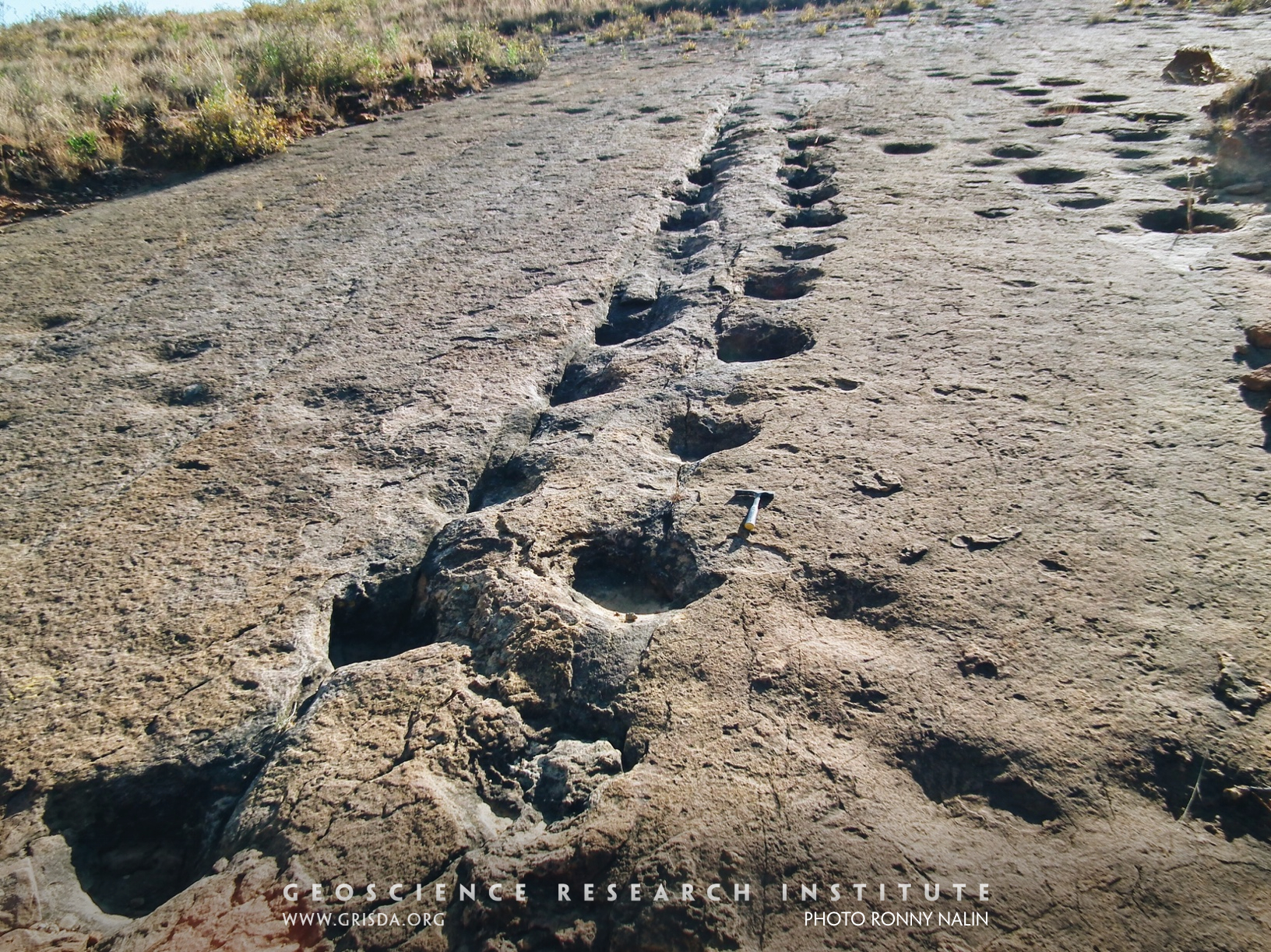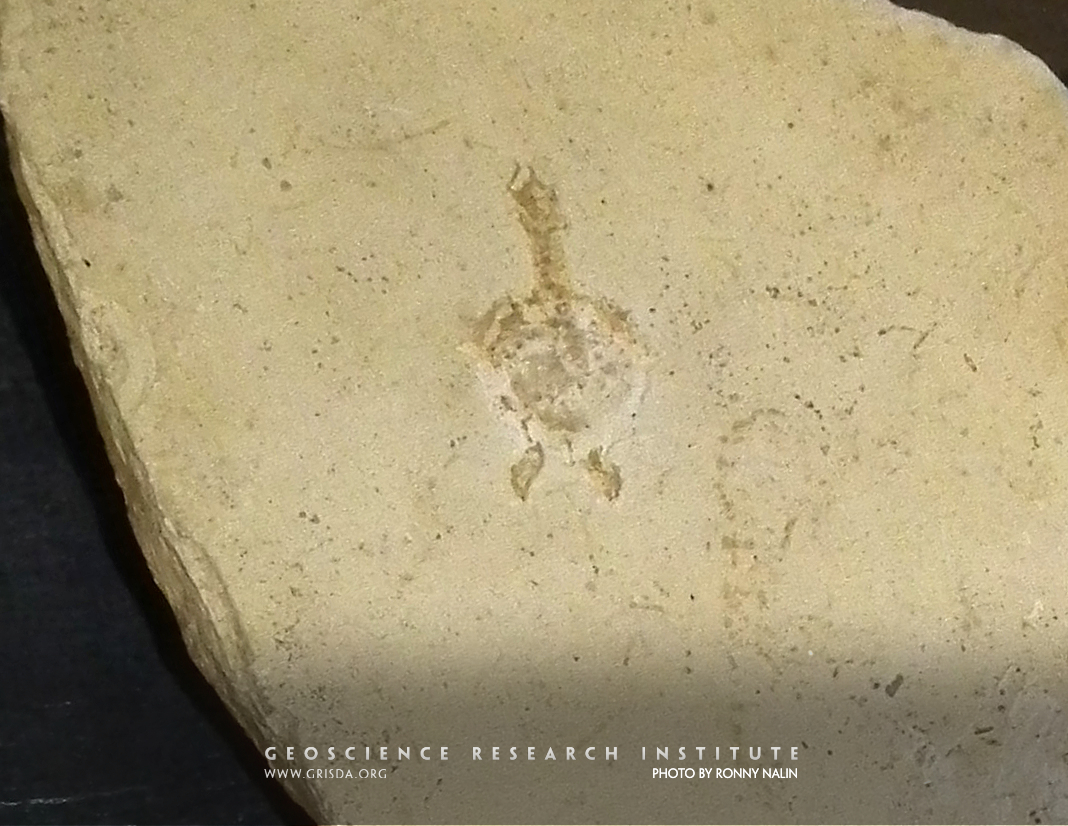©Copyright 2018 GEOSCIENCE RESEARCH INSTITUTE
11060 Campus Street • Loma Linda, California 92350 • 909-558-4548

Bioturbation
A variety of invertebrate organisms live and feed within the soft sediment accumulating under water. The activity of these organisms, known as bioturbation, can leave traces in the sediments of the substrate. These traces can become fossilized, as is the case for this Cretaceous sandstone from the coast of Chile. The meniscate patterns in the sand are indicative of bioturbation. Surface view of bed, pencil for scale.
Paleocene Maragua Bolivia
Succession of Upper Cretaceous and Cenozoic sediments in the Maragua syncline region, Bolivia
Dastilbe crandalli
A fossilized example of predation. This Cretaceous fish from the Crato Formation of the Araripe Basin, Brazil, died while ingesting another fish. Specimen on display at the Paleontological Museum in Santana do Cariri, few cm in size.
Dinodiplura ambulacra
Exceptional preservation of organisms without hard skeletal parts, like this spider, requires special conditions for fossilization. Spiders appear abruptly in the fossil record. This is a Cretaceous specimen (few cm in size) of Dinodiplura ambulacra from the Crato Formation of Brazil, on display at the Paleontological Museum in Santana do Cariri.
Cannibalism
Cannibalism exhibited by the fish Dastilbe crandalli, Cretaceous Crato Fm., Brazil. Specimen on display at the Paleontological Museum in Santana do Cariri. Larger fish is about 10 cm in size. Unique environmental conditions are required for such spectacular preservation of fossil fish. This form of cannibalism is also interpreted as indicative of stressful environmental conditions.
Dinosaur trackways
Dinosaur trackways, the main one thought to have been left by an ankylosaurid (hammer for scale). Cretaceous El Molino Fm., Torotoro, Bolivia. Well developed fossil trackways imply a special set of conditions, with sediment wet enough for footprints to remain impressed followed by prompt induration and burial.
Mud cracks and ripples
On the surface of this Cretaceous mudstone bed from the Sousa Basin of Brazil, one can see both polygonal cracks (indicative of subaerial exposure) and wave ripples (indicative of a thin cover of water).
Brachyphyllum obesum
Fossil branches and leaves of an araucarian tree from the Cretaceous of the Crato Basin, Brazil. On display at the Paleontological Museum of Santana do Cariri
Fossil feather
Fossil feather from the Crato Formation, Cretaceous, Brazil. It is possible that this feather belonged to an individual of the bird species Cratoavis cearensis. Specimen on display at the Paleontological Museum of Santana do Cariri
Pterosaur
3D preservation of pterosaur bones, in articulation, is extremely rare and requires special conditions for fossilization. This example comes from a concretion within the Cretaceous Romualdo Formation, Brazil. On display at the Paleontological Museum in Santana Do Cariri
Araripemys barretoi
Fossilized hatchling of a Cretaceous pleurodiran turtle from the Araripe Basin, Brazil. Specimen on display at the Paleontological Museum in Santana do Cariri, few cm in size.
Ripple cross-lamination
Cross-sectional view of a calcareous mudstone to fine-sandstone bed, showing planar lamination passing upward to ripple-cross lamination. The symmetric shape of the ripples, the presence of foreset laminae dipping in opposite directions, and some lamina draping suggest that the cross-lamination was likely generated by wave-ripples. The sequence from planar lamination to ripple cross-lamination can be indicative of decreasing velocity of bottom currents (or changes in sediment grainsize and supply rate). Diameter of lens cap is 6 cm. Photo taken at the I-70 roadcut, near Morrison, Colorado (Cretaceous Dakota Group).
Wave ripples
Wave ripples in surface view (scale is 40 cm long). The crests are straight and regularly spaced. However, the overlying thin layer (top of the picture) shows a more disorganized pattern, partly reflecting the underlying crest orientation but probably indicating changing wave conditions. The preservation of these bedforms (that typically form in shallow water) can help to reconstruct the environment of deposition of sedimentary layers. Outcrop of the Cretaceous Dakota Sandstone, exposed along Dinosaur Ridge, Golden, Colorado.
Aspidiophyllum obtusum
Flowering plants appear abruptly in the fossil record in Mesozoic strata. Here is an example of an exquisitely preserved sycamore-like leaf from the Cretaceous of Kansas. Specimen (several cm in size) on display at the Field Museum of Natural History, Chicago.
Raindrop impressions?
These circular impressions, exposed on the underside surface of a layer of fine sandstone, have been interpreted as raindrop impressions. Sedimentologists have cautioned that similar impressions can form in muddy substrates by the ascent of bubbles through the sediment, or by interaction with air bubbles trapped in the overlying fluid. Scale in cm. Outcrop of the Maastrichtian Laramie Fm., exposed along the Triceratops trail Golden, CO, US.
Marginocephalians
Marginocephalians are a group of herbivorous dinosaurs found in Cretaceous layers and characterized by a bony frill at the back of their skull. This photo shows specimens of 4 different species within this group, on display at the Field Museum of Natural History, Chicago.
Araripescorpius ligabuei
The body plan of fossil scorpions is not much different from modern ones: an example of morphological stasis. This is a Cretaceous example from the Crato Formation of Brazil. Specimen on display at the Paleontological Museum in Santana do Cariri, few cm in size.
Fossil snake
Snakes appear in the fossil record in Mesozoic layers. Here is a cast of a fully articulated specimen from the Cretaceous of Bosnia-Herzegovina, on display at the Field Museum of Natural History, Chicago.
Taniwhasaurus
Replica of the skeleton of a Cretaceous large marine reptile, Taniwhasaurus antarcticus, on display at the Chicago Field Museum of Natural History. Remains of this reptile are found in locations both within the southern and northern hemisphere, illustrating an example of widespread distribution of a fossil type.
Platyceramus platinus
Dinosaurs are not the only group of organisms to disappear above Cretaceous strata. Inoceramids, a family of large bivalves, are also extinct and not found in Cenozoic layers. Remains of fish have been found preserved within some specimens of this giant clam, leading to the suggestion of possible commensalism or symbiosis. Specimen on display at the Colorado Museum of Nature and Science.
Dinosaur Ridge Trackway
The Dinosaur Ridge Tracksite, in Golden, CO, preserves two main types of dinosaur footprints. Both are tridactyl (with three toes). They have been colored in with charcoal to enhance their visibility. The tracks with a wider aspect and thick toes were made by ornithopod dinosaurs. They were left by animals of different sizes (possibly adults and juveniles). The narrow-toed tracks were made by theropods. See if you can recognize the different tracks. This outcrop exposes the surface of a sandstone bed in the Lower Cretaceous South Platte Formation of the Dakota Group.
Palm fronds
Fossil impressions of palm fronds exposed on a verticalized bedding surface of fine sandstone in the Maastrichtian Laramie Formation, near Golden CO. The integrity of individual fronds implies that minimal decomposition took place prior to burial. Scale bar is 40 cm long.
Coccoliths
Calcareous nannofossils (coccoliths) are among the tiniest fossils preserved in the sedimentary record, measuring around 5 to 10 microns. The image (plate) shows petrographic microscope photos of some of the most characteristic coccoliths of the Cretaceous/Paleogene (K/Pg) boundary. This boundary is associated with one of the most studied mass extinctions in the geological record, which has been correlated to a major catastrophic event. Photos 1 to 4 show nannofossils of the Upper Cretaceous (Maastrichtian) that are thought to have gone extinct at the K-Pg catastrophic event. Photos 5 to 7 are of Cretaceous survivors that show continuous distribution into the Paleogene (Danian). These last species are considered adapted to cold water and eutrophic environments (r-selected taxa). Photos 8 and 9 show Paleogene taxa, not present below the boundary. (Photos by E. Belia)






















